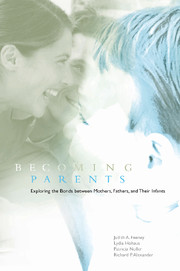Book contents
- Frontmatter
- Contents
- Preface
- 1 The Transition to Parenthood
- 2 Attachment in Childhood and Beyond
- 3 The Study
- 4 The Couples
- 5 Pregnancy and Plans for Birth
- 6 Couples' Experiences of Birth and New Parenthood
- 7 How Does New Parenthood Affect Couples?
- 8 Dealing with Depression
- 9 Men, Women, and Household Work: The Diaries
- 10 Couples' Changing Attachment Relationships
- 11 Six Months into Parenting
- 12 New Parenthood in Perspective
- Appendix A Core Questionnaires Completed by Couples
- Appendix B Summary of Sample Characteristics
- Appendix C Summary of Major Statistical Analyses
- References
- Author Index
- Subject Index
8 - Dealing with Depression
Published online by Cambridge University Press: 05 June 2012
- Frontmatter
- Contents
- Preface
- 1 The Transition to Parenthood
- 2 Attachment in Childhood and Beyond
- 3 The Study
- 4 The Couples
- 5 Pregnancy and Plans for Birth
- 6 Couples' Experiences of Birth and New Parenthood
- 7 How Does New Parenthood Affect Couples?
- 8 Dealing with Depression
- 9 Men, Women, and Household Work: The Diaries
- 10 Couples' Changing Attachment Relationships
- 11 Six Months into Parenting
- 12 New Parenthood in Perspective
- Appendix A Core Questionnaires Completed by Couples
- Appendix B Summary of Sample Characteristics
- Appendix C Summary of Major Statistical Analyses
- References
- Author Index
- Subject Index
Summary
“Dealing with the child, that's okay, but a crying wife is a bit harder to deal with.”
Depression was another important issue that emerged from both interview and questionnaire responses when the new parents' babies were about six weeks old. At this point, some of the mothers acknowledged that they were having considerable difficulty with feelings of gloom, pessimism, and hopelessness. In this chapter, we focus on the experiences of these women. We wanted to understand the nature of the problems they were experiencing, to examine the factors that might be linked to their depression, and to see how they were faring at the end of the study.
POSTNATAL DEPRESSION
Studies of new mothers suggest that postnatal depression is not a rare phenomenon; in fact, between 8% and 15% of women may be affected by this problem (O'Hara, 1997). Although the defining characteristic of postnatal depression is “dysphoric” (or depressed) mood, this mood state is usually accompanied by other symptoms, such as extreme fatigue, strong feelings of guilt, and disturbances of sleep and appetite. A diagnosis of postnatal depression usually requires that these symptoms be present over a reasonable period of time, and affect the woman's ability to function effectively (O'Hara, 1997).
These diagnostic criteria highlight the scope of the problems associated with postnatal depression. When a new mother cannot function effectively, there are serious implications for her own adjustment, for the care and management of the baby, and for the couple relationship.
- Type
- Chapter
- Information
- Becoming ParentsExploring the Bonds between Mothers, Fathers, and their Infants, pp. 129 - 144Publisher: Cambridge University PressPrint publication year: 2001

